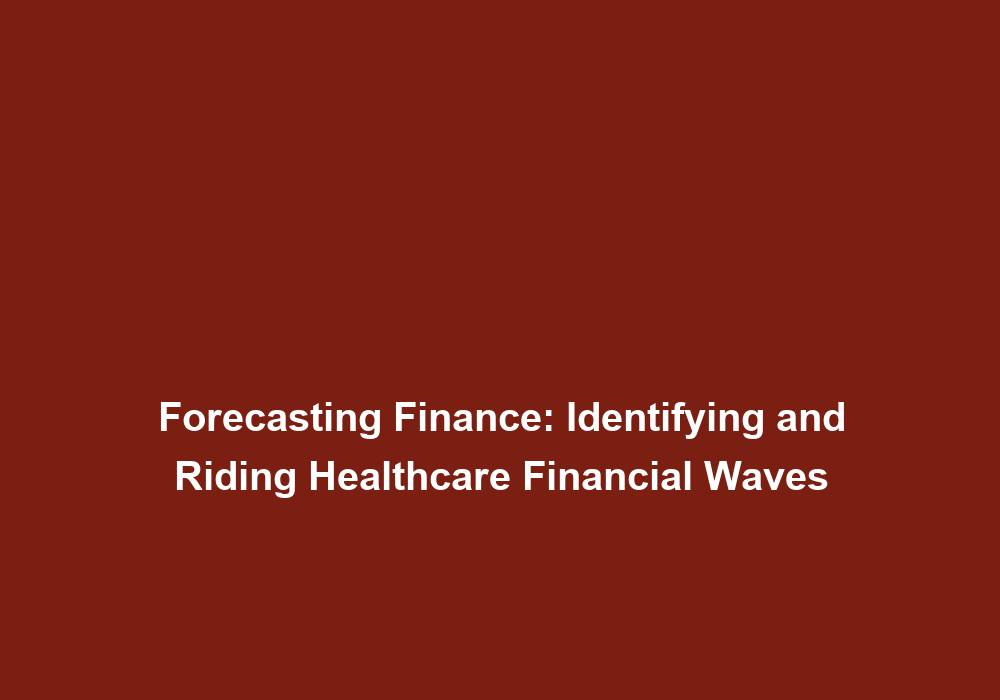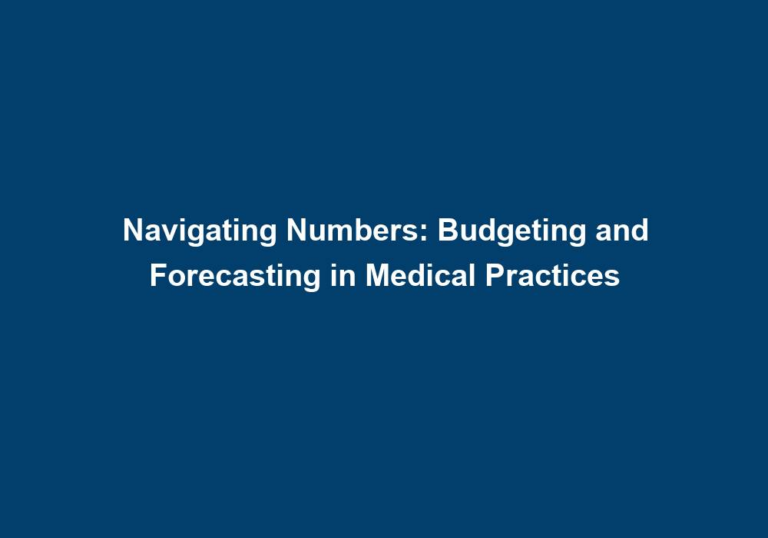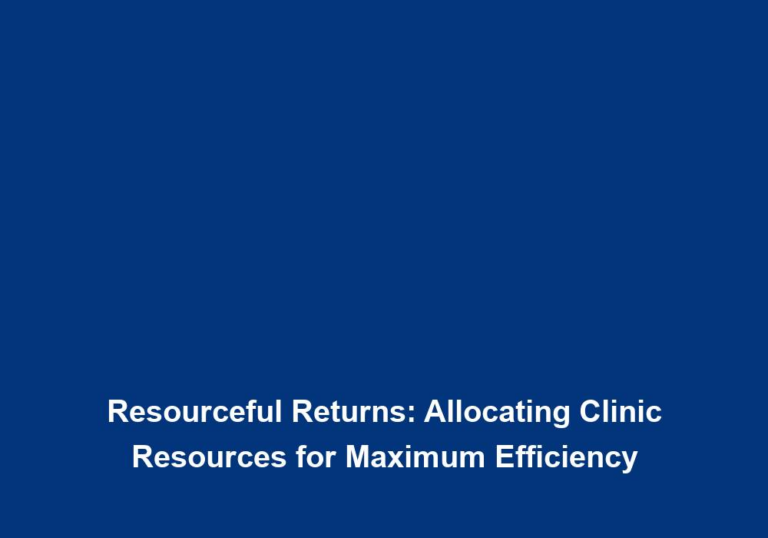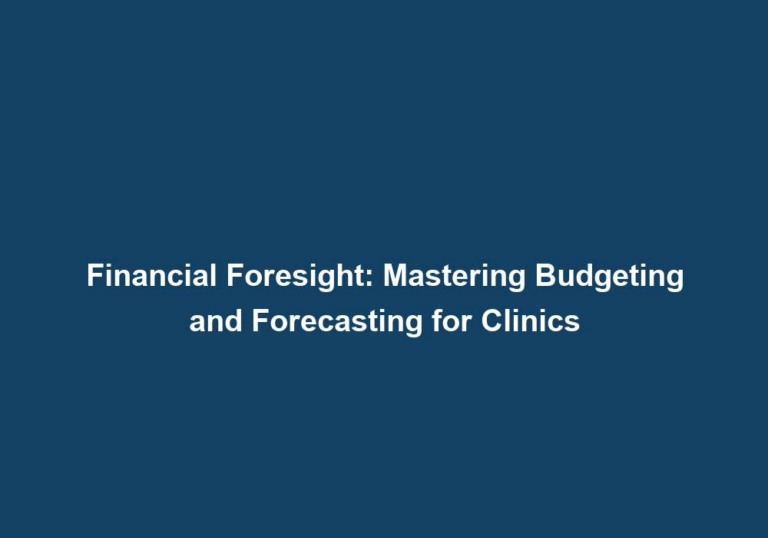Forecasting Finance: Identifying and Riding Healthcare Financial Waves
In the ever-evolving landscape of healthcare, financial forecasting plays a vital role in ensuring stability, growth, and success. The ability to identify and ride healthcare financial waves can be a significant advantage for organizations looking to navigate the complex world of healthcare finance. In this article, we will explore the importance of financial forecasting in the healthcare industry and discuss strategies to effectively anticipate and adapt to financial changes.
Why Financial Forecasting Matters in Healthcare
Financial forecasting is the process of estimating future financial outcomes based on historical data, trends, and other relevant factors. In the healthcare industry, accurate financial forecasting is crucial for several reasons:
1. Cost Management: Healthcare organizations need to effectively manage costs to ensure profitability and sustainability. Financial forecasting allows for the identification of potential cost drivers and helps in making informed decisions to optimize resource allocation.
Effective cost management is essential for healthcare organizations to maintain financial stability and provide high-quality patient care. By accurately forecasting financial outcomes, organizations can identify potential cost drivers and take proactive measures to optimize resource allocation. This includes analyzing historical data, identifying trends, and considering other relevant factors to make informed decisions. Financial forecasting also helps in aligning costs with revenue projections, ensuring that healthcare organizations can maintain profitability and sustainability in a rapidly changing landscape.
2. Revenue Projections: Forecasting financial outcomes enables healthcare organizations to predict revenue streams accurately. This information is essential for budgeting, financial planning, and ensuring the availability of resources to provide high-quality patient care.
Accurate revenue projections are crucial for healthcare organizations to effectively plan and allocate resources. Financial forecasting allows organizations to anticipate revenue streams and align them with budgeting and financial planning. By analyzing historical data, trends, and other relevant factors, healthcare organizations can make informed projections about future revenue and ensure the availability of resources to provide high-quality patient care. This includes considering factors such as changes in payer mix, reimbursement models, and patient volumes, allowing organizations to adapt their strategies accordingly.
3. Capital Investment Planning: Healthcare organizations often require substantial capital investments for infrastructure, technology, and expansion. Financial forecasting assists in determining the feasibility of such investments and supports strategic decision-making.
Capital investment planning is crucial for healthcare organizations to adapt to evolving industry trends and enhance patient care. Financial forecasting plays a key role in assessing the feasibility of capital investments by analyzing historical data, trends, and other relevant factors. This allows organizations to make informed decisions about infrastructure development, technology adoption, and expansion plans. By accurately forecasting financial outcomes, healthcare organizations can strategically allocate resources, optimize financial performance, and ensure long-term sustainability.
4. Risk Mitigation: By analyzing financial trends and patterns, organizations can identify potential risks and uncertainties. This enables proactive risk mitigation strategies, such as developing contingency plans, diversifying revenue streams, or exploring new business opportunities.
Risk mitigation is essential for healthcare organizations to navigate the uncertainties of the healthcare financial landscape. Financial forecasting allows organizations to analyze historical data, trends, and patterns to identify potential risks and uncertainties. This includes factors such as changes in regulations, shifts in payer mix, or fluctuations in patient volumes. By accurately forecasting financial outcomes, healthcare organizations can develop proactive risk mitigation strategies. This may involve developing contingency plans, diversifying revenue streams, exploring new business opportunities, or implementing cost-saving measures. By effectively identifying and addressing potential risks, healthcare organizations can enhance financial stability and ensure long-term success.
The Healthcare Financial Landscape
Before delving into the specifics of forecasting healthcare finance, it is essential to understand the key components and challenges of the healthcare financial landscape. Here are some crucial factors to consider:
1. Regulatory Environment
The healthcare industry operates in a heavily regulated environment, with numerous laws, policies, and reimbursement guidelines. Changes in regulations can significantly impact financial operations, making it imperative for organizations to stay updated and adapt to new requirements.
The regulatory environment in healthcare is dynamic and constantly evolving. Healthcare organizations must stay informed about changes in regulations and reimbursement guidelines that may affect their financial operations. This includes staying updated on policies related to billing, coding, reimbursement rates, and compliance requirements. By monitoring and adapting to changes in the regulatory environment, healthcare organizations can ensure compliance and mitigate potential financial risks.
2. Payer Mix
The payer mix refers to the composition of patients’ sources of payment, such as private insurance, government programs (Medicare, Medicaid), or self-pay. Healthcare organizations need to analyze their payer mix to understand revenue streams and anticipate any shifts that may affect financial stability.
Analyzing the payer mix is essential for healthcare organizations to understand their revenue streams and adapt to changes in the healthcare landscape. This includes analyzing the percentage of patients covered by private insurance, government programs, or self-pay options. By understanding the payer mix, organizations can anticipate any shifts, such as changes in reimbursement rates or the introduction of new payment models. This information helps healthcare organizations adjust their financial strategies, optimize revenue generation, and maintain financial stability.
3. Reimbursement Models
Healthcare reimbursement models have evolved over time, with a shift towards value-based care. Organizations must understand the intricacies of reimbursement models, such as diagnosis-related groups (DRGs) or bundled payments, to accurately forecast revenue and optimize financial performance.
Understanding the complexities of reimbursement models is essential for healthcare organizations to effectively forecast revenue and optimize financial performance. Reimbursement models such as diagnosis-related groups (DRGs) or bundled payments can have a significant impact on revenue generation. By analyzing historical data, trends, and patterns, healthcare organizations can make informed projections about future revenue based on these reimbursement models. This allows organizations to optimize financial performance, align resources, and provide high-quality patient care while adapting to the changing healthcare landscape.
4. Technological Advancements
The healthcare industry is experiencing rapid technological advancements, including electronic health records (EHRs), telemedicine, and data analytics. Embracing these technologies can improve efficiency, reduce costs, and enhance patient care. However, organizations must consider the financial implications of these investments during the forecasting process.
Technological advancements have the potential to revolutionize healthcare delivery and financial management. Implementing technologies such as electronic health records (EHRs), telemedicine, and data analytics can improve operational efficiency, reduce costs, and enhance patient care. However, healthcare organizations must consider the financial implications of these investments during the forecasting process. This includes assessing the upfront costs, ongoing maintenance expenses, and potential return on investment. By incorporating technological advancements into financial forecasting, healthcare organizations can make informed decisions about adopting new technologies and optimize financial performance.
Strategies for Effective Financial Forecasting in Healthcare
To effectively forecast healthcare finance, organizations can employ several strategies and best practices. Here are some key considerations:
1. Historical Data Analysis
Analyzing historical financial data is a crucial step in forecasting healthcare finance. By examining trends, patterns, and seasonality, organizations can identify recurring opportunities and challenges. This analysis helps in establishing baseline financial projections and identifying areas for improvement.
Analyzing historical financial data provides valuable insights for forecasting healthcare finance. By examining trends, patterns, and seasonality, organizations can identify recurring opportunities and challenges. This analysis helps in establishing baseline financial projections and identifying areas for improvement. It also allows healthcare organizations to identify key performance indicators (KPIs) and track their financial performance over time. By leveraging historical data analysis, organizations can make informed decisions, optimize resource allocation, and improve financial forecasting accuracy.
2. Collaboration and Data Sharing
Collaboration between finance, operations, and clinical teams is essential for accurate financial forecasting. Sharing data and insights across departments enables a holistic understanding of the impact of clinical activities on financial outcomes. This collaboration also facilitates the identification of cost-saving opportunities and the development of more accurate financial projections.
Effective collaboration and data sharing across departments are crucial for accurate financial forecasting in healthcare. Finance, operations, and clinical teams must work together to understand the impact of clinical activities on financial outcomes. By sharing data and insights, organizations can develop a holistic view of the financial implications of clinical operations. This collaboration enables the identification of cost-saving opportunities, optimization of resource allocation, and the development of more accurate financial projections. By leveraging the expertise and perspectives of various teams, healthcare organizations can enhance their financial forecasting capabilities and improve overall financial performance.
3. Scenario Planning
Healthcare organizations operate in a dynamic environment with numerous uncertainties. Scenario planning involves creating multiple financial forecasts based on different potential scenarios. This approach allows organizations to assess the financial impact of various events or changes, such as policy reforms, shifts in payer mix, or fluctuations in patient volumes.
Scenario planning is a valuable strategy for healthcare organizations to effectively anticipate and adapt to financial changes. By creating multiple financial forecasts based on different potential scenarios, organizations can assess the financial impact of various events or changes. This includes changes in regulations, shifts in payer mix, fluctuations in patient volumes, or policy reforms. By considering these scenarios, healthcare organizations can develop contingency plans, identify potential risks, and make informed decisions to optimize financial performance. Scenario planning enhances the organization’s ability to proactively respond to changing circumstances and ensure financial stability.
4. Financial Performance Monitoring
Regular monitoring of financial performance is essential for forecasting accuracy. By tracking key performance indicators (KPIs) such as revenue, expenses, and profit margins, organizations can identify deviations from projected outcomes promptly. This monitoring enables timely adjustments and proactive measures to ensure financial goals are met.
Monitoring financial performance is a critical component of effective financial forecasting in healthcare. By tracking key performance indicators (KPIs) such as revenue, expenses, and profit margins, organizations can assess their financial performance and identify any deviations from projected outcomes. This monitoring allows healthcare organizations to promptly identify any issues, make necessary adjustments, and take proactive measures to ensure financial goals are met. By continuously monitoring financial performance, organizations can enhance forecasting accuracy, optimize resource allocation, and improve overall financial stability.
5. Continuous Education and Adaptation
Given the rapidly changing healthcare landscape, continuous education and adaptation are crucial for effective financial forecasting. Staying informed about industry trends, regulatory changes, and emerging financial strategies allows organizations to proactively adjust their forecasting models and mitigate potential risks.
Continuous education and adaptation are essential for healthcare organizations to stay ahead in the ever-evolving healthcare landscape. This includes staying informed about industry trends, regulatory changes, and emerging financial strategies. By continuously educating themselves, healthcare organizations can stay updated on best practices, industry benchmarks, and innovative financial strategies. This knowledge allows organizations to proactively adjust their forecasting models, optimize financial performance, and mitigate potential risks. By embracing a culture of continuous learning and adaptation, healthcare organizations can enhance their ability to forecast financial outcomes and make informed decisions that positively impact patient care and financial sustainability.
Conclusion
In the complex world of healthcare finance, accurate financial forecasting is a key driver of success. By identifying and riding healthcare financial waves, organizations can navigate challenges, seize opportunities, and ensure long-term financial stability. Through strategies such as historical data analysis, collaboration, scenario planning, financial performance monitoring, and continuous education, healthcare organizations can enhance their ability to forecast financial outcomes and make informed decisions that positively impact patient care and financial sustainability.
This article is written by a SEO content writing expert, fluent in English, specializing in healthcare finance.






